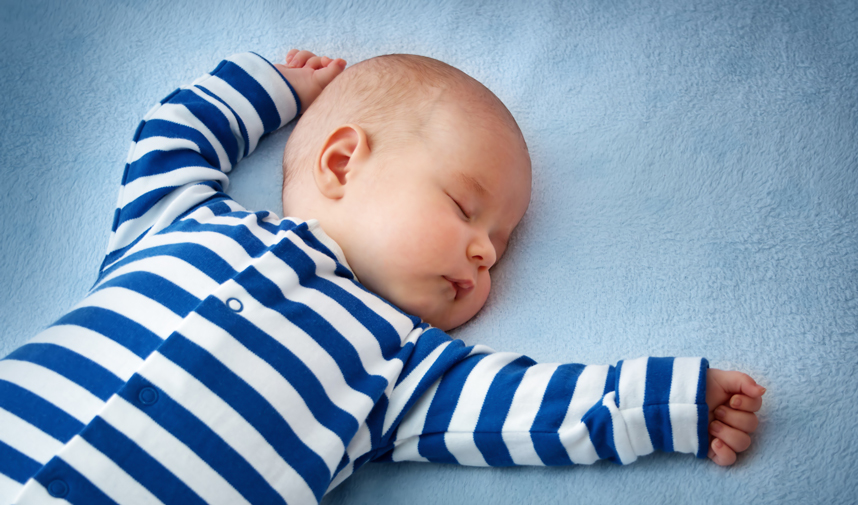Sleep is important for your baby’s health, growth and development. Putting your baby down to sleep on their back, in a safe place, in the right clothes and at a comfortable temperature can let you rest easier.
Babies should sleep on their backs in a crib or bassinet with only a tight-fitting sheet. Keep your baby warm with clothing like a onesie.

Back to Sleep
Babies should always sleep on their backs to reduce the risk of SIDS (sudden infant death syndrome). SIDS can happen when a baby cannot breathe easily. Babies should be put to sleep on their backs for the first 12 months.
If your baby falls asleep in a carrier or car seat, lay them down flat in a crib with a firm mattress as soon as you can. This is to avoid a blocked airway.
When your baby starts rolling over
It’s OK for your baby to roll onto their stomach after you put them in their crib, if they can easily roll onto their back as well. Stop swaddling a baby who has started trying to roll over.
Sleep Safety Away from Home
When you travel with your baby, bring a portable crib or bassinet. This lets you put your baby down to sleep on a safe, flat, firm mattress, just like at home. Don’t put your baby to sleep on a chair, sofa or full-size bed.
Comfortable, Safe Sleep Clothes
Dress your baby for sleep in close-fitting clothes, like a onesie. Clothes and blankets should not be able to get loose and cover your baby’s face. A sleep sack can keep your baby warm, but it stays away from their nose and mouth. If you swaddle your baby, make sure the blanket will not come loose. Put your baby in only one more layer of clothes than you would wear, so they don’t get too warm.
Smoke-Free Home
Being around smoke increases your baby’s risk of SIDS. This includes smoke from tobacco and vaping products, as well as wood fires, candles and incense. Don’t let anyone smoke or vape around your baby or in your home.
Comfortable, Safe Temperature
Your baby should sleep in your room. If the temperature is comfortable for you, it is the right temperature for your baby, too. Avoid letting your baby get too warm while they sleep, because this increases the risk of SIDS. If your baby is sweating or their chest is hot, they are getting too warm.
Crib Safety
We imagine that soft, fluffy things nurture and comfort babies, because they comfort us. But soft things like toys and pillows are dangerous in a crib or bassinet. Save these for outside the crib, and when your baby is awake and you are watching them. When you are setting up a safe place for your baby to sleep, keep these guidelines in mind:
- Have your baby sleep in a crib or bassinet in your room. Don’t let your baby sleep in your bed.
- Use a firm, tight-fitting mattress with a fitted crib sheet. There should be no space between the mattress and the crib sides.
- Do not put loose blankets, comforters, pillows, bumper pads or stuffed toys in the crib. (A new law bans crib bumpers as being dangerous.)
- Keep all cords away from the crib. This includes cords on curtains and shades, lights, bedding, and toys.
Choose a Safe Crib
- Use a crib that meets current safety standards. If you are using an old crib, make sure it was made after 2011. That is when crib safety standards were improved.
- If you need help affording a safe crib, ask your hospital or local health department, or contact Cribs for Kids.
- Do not use a crib with a drop rail or decorative cutouts on the headboard or footboard.
- A crib’s bars are too far apart if a soda can will fit between them. Your baby could get their head, hand or foot stuck in the space.
Pacifier Safety
It’s OK to give your baby a pacifier when you put them down to sleep. It may help prevent SIDS. Here are some tips for using a pacifier safely.
- Choose one-piece, dishwasher-safe pacifiers. The hard plastic shields should be at least 1 inches across.
- As your baby grows, make sure they cannot get the whole pacifier and shield into their mouth. If this happens, get some bigger pacifiers.
- Never tie a pacifier to your baby’s body, clothes or crib. This can cause injuries or strangling.
- Replace pacifiers when the rubber nipple gets torn or turns a different color.
More Ways to Find Help
Healthy Children – Information on sleep safety, written by doctors.
The First Things First Parent Kit was developed in partnership with Health Research for Action/UC Berkeley. © 2022 The Regents of the University of California. Additional video, graphic and other content © 2022 First Things First. All rights reserved.


